This post was written by Dana Gulley ’17, founder and lead consultant of Third Peak Solutions. She can be reached at dana@thirdpeaksolutions.com.
You could say I was stoked when the postal carrier slid the May 14th edition of High Country News through my mail slot last month. The twice-monthly magazine covers conservation issues “for people who care about the West,” and over the last nine months, this New Yorker had become one of those people. Flipping through the pages, “Your stoke won’t save us: the idea that outdoor recreation leads to meaningful conservation rests on a very big ‘if,’” by Ethan Linck, jumped off the page at me.
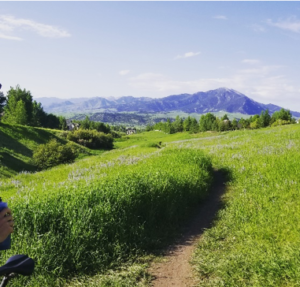 Since moving to the little city of Bozeman, Montana last fall, my increased focus on rock climbing, mountain biking (photo, left), canoeing and backpacking has brought me closer to the outdoor recreation community, a community that is at the heart of this place and many others like it. That said, I’ve felt strangely further away from my conservation roots. I devoured the article, nodding, admittedly a bit self-righteously, through all 3,000 words. Yes, yes! This is what I have been saying. Outdoor recreation does not solely predict one’s environmental attitudes! While the outdoor recreation industry is willing to make increasingly political statements about protecting our wild places, they’re yet to show they are willing to pay for that protection! And my sustainable business training rushed back: we don’t need to settle for trade-offs! Businesses can do well by doing good.
Since moving to the little city of Bozeman, Montana last fall, my increased focus on rock climbing, mountain biking (photo, left), canoeing and backpacking has brought me closer to the outdoor recreation community, a community that is at the heart of this place and many others like it. That said, I’ve felt strangely further away from my conservation roots. I devoured the article, nodding, admittedly a bit self-righteously, through all 3,000 words. Yes, yes! This is what I have been saying. Outdoor recreation does not solely predict one’s environmental attitudes! While the outdoor recreation industry is willing to make increasingly political statements about protecting our wild places, they’re yet to show they are willing to pay for that protection! And my sustainable business training rushed back: we don’t need to settle for trade-offs! Businesses can do well by doing good.
The euphoria of seeing my opinion in ink was quickly replaced by guilt. Okay, so our environmental issues continue to mount and there’s opportunity being left on the table. What have I done about it? Those petitions I hawked as the outreach director for Riverkeeper, a clean water nonprofit in New York’s Hudson Valley, seemed like a distant memory, even though I spend more time in outdoor places than ever before in my life. And as a strategy consultant, I have found myself focusing on the more familiar world of non-profits as opposed to supporting and promoting sustainable businesses. As stoked as I was to read the article, I felt simultaneously counterfeit. With all the changes in my life, I had somehow lost my tribe: that community that is so essential to having the courage to face a big problem and do something about it. And I knew that tribe must exist here. After all, in 2015 the Montana state legislature was the 29th in the nation to pass a law that allows companies to legally register as benefit corporations.
Later that week, Business for Montana’s Outdoors, a coalition that includes some 180 businesses, hosted a panel discussion, “Tech and the Outdoors: How the ‘Montana Mystique’ is Fueling Business Growth.” In Montana, the tech industry provides 15,000 jobs and $1.03 billion in wages, and it’s growing fast. Panelists from several of Bozeman’s mature tech companies and start-ups focused on the competitive advantage Montana’s outdoors provides in everything from attracting and retaining talent to entertaining clients and customers. Panelists shared countless examples of how their companies were more successful because of Montana’s beautiful and enjoyable natural environment. What they didn’t share, were innovative ideas for how their businesses would ensure the ongoing protection of the outdoors, something they acknowledged was a critical asset.
The research shows that millennials are increasingly interested in being part of companies that they can feel proud of, companies that are actively doing something about the problems we face. And in the age of Patagonia replacing its product homepage with “The President Stole Your Land,” while mounting an aggressive lawsuit to fight the historic removal of public lands in Bear’s Ears National Monument, businesses have more permission than ever to act. Determined to push the envelope and proudly gripping the High Country News magazine, I stood up, and channeled the collective strength of my tribe, my Sustainable Innovation MBA cohort from the University of Vermont. I hear how Montana’s outdoors helps you, but how will you help the outdoors?
While I was initially frustrated by the lackluster response (some non-profit donations here, a volunteer trail building day there), this experience reminded me of something I had lost sight of: if we are to overcome the momentum of the status quo that pushes businesses to think the same way they always have, then we must each harness our respective tribes and act now. Businesses need our help, as consumers and consultants, to innovate new models of corporate social responsibility that address the world’s problems while helping them thrive. We don’t have to start from scratch. As an outdoor recreator, I can be an ambassador for environmental advocacy in my community, limit my consumption by purchasing used gear or new gear from unparalleled companies like Patagonia, and support organizations like Protect our Winters (POW), a climate advocacy group that organizes outdoor enthusiasts to take action. As a consultant, I can build on the momentum of the 2015 law here in Montana to pursue for-profit clients and develop and share sustainable business best practices.
In case it inspires you to act, too, consider this my call for tribe-members and to recommitting myself to contribute to solutions instead of nodding along vigorously at the problems. And while these actions alone won’t save us, I’m stoked to do my part.
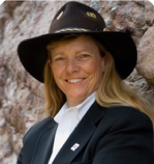 Earlier this Fall we had the pleasure of hosting guest speaker Hunter Lovins. Suffice it to say, she knocked our socks off. I had heard Hunter’s name before, but wasn’t very familiar with her work or legacy. It became apparent right away that we were in for a unique and inspiring experience.
Earlier this Fall we had the pleasure of hosting guest speaker Hunter Lovins. Suffice it to say, she knocked our socks off. I had heard Hunter’s name before, but wasn’t very familiar with her work or legacy. It became apparent right away that we were in for a unique and inspiring experience.
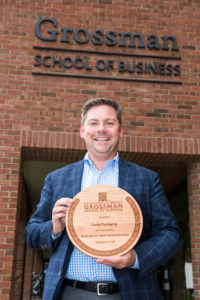
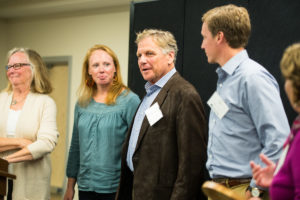
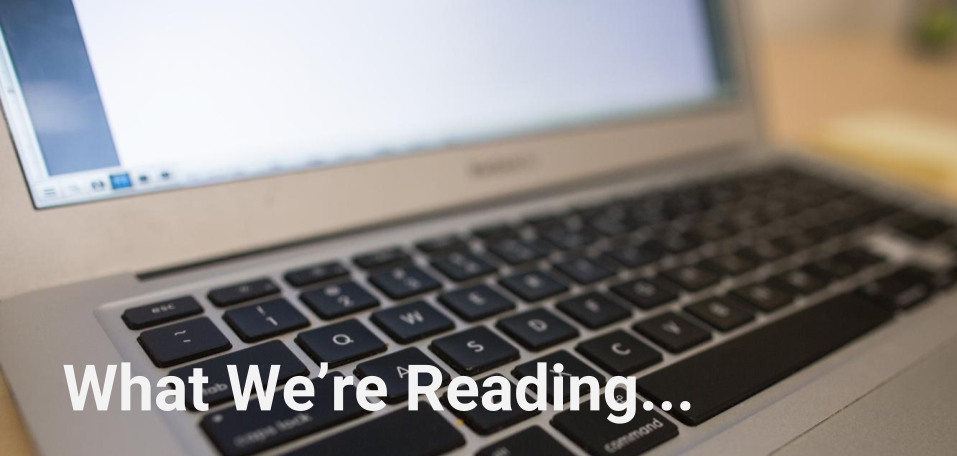 An occasional curation of sustainable innovation and business transformation news, postings, et cetera…
An occasional curation of sustainable innovation and business transformation news, postings, et cetera…
 Today, the importance of LEED is underestimated, and the students believe that it will soon become the norm, becoming part of all building codes. The built environment accounts for more than a third of our total energy usage, as well as an immense amount of fresh water. And buildings take up a lot of space, disrupting natural drainage systems and increasing the urban heat island affect. Leadership in Energy and Environmental Design (LEED) is a certification system made to create greener buildings and more livable urban environments. It is estimated that people will spend up to 90% of their time indoors, so it makes sense to prioritize both healthier and more environmentally friendly buildings.
Today, the importance of LEED is underestimated, and the students believe that it will soon become the norm, becoming part of all building codes. The built environment accounts for more than a third of our total energy usage, as well as an immense amount of fresh water. And buildings take up a lot of space, disrupting natural drainage systems and increasing the urban heat island affect. Leadership in Energy and Environmental Design (LEED) is a certification system made to create greener buildings and more livable urban environments. It is estimated that people will spend up to 90% of their time indoors, so it makes sense to prioritize both healthier and more environmentally friendly buildings. Since moving to the little city of Bozeman, Montana last fall, my increased focus on rock climbing, mountain biking (photo, left), canoeing and backpacking has brought me closer to the outdoor recreation community, a community that is at the heart of this place and many others like it. That said, I’ve felt strangely further away from my conservation roots. I devoured the article, nodding, admittedly a bit self-righteously, through all 3,000 words. Yes, yes! This is what I have been saying. Outdoor recreation does not solely predict one’s environmental attitudes! While the outdoor recreation industry is willing to make increasingly political statements about protecting our wild places, they’re yet to show they are willing to pay for that protection! And my sustainable business training rushed back: we don’t need to settle for trade-offs! Businesses can do well by doing good.
Since moving to the little city of Bozeman, Montana last fall, my increased focus on rock climbing, mountain biking (photo, left), canoeing and backpacking has brought me closer to the outdoor recreation community, a community that is at the heart of this place and many others like it. That said, I’ve felt strangely further away from my conservation roots. I devoured the article, nodding, admittedly a bit self-righteously, through all 3,000 words. Yes, yes! This is what I have been saying. Outdoor recreation does not solely predict one’s environmental attitudes! While the outdoor recreation industry is willing to make increasingly political statements about protecting our wild places, they’re yet to show they are willing to pay for that protection! And my sustainable business training rushed back: we don’t need to settle for trade-offs! Businesses can do well by doing good. In 2 years, all new homes built in the state will be mandated to either have solar panels installed or be hooked up to shared solar panels that power a grouping of the new homes. New home buyers will have the option to purchase the panels outright where they are included in the price of the home or can be leased. The increasing amount of solar energy to be included in the energy mix is sure to help achieve the state’s aforementioned energy goals, but the requirement for new home owners to purchase rooftop solar has the potential to surface unintended consequences.
In 2 years, all new homes built in the state will be mandated to either have solar panels installed or be hooked up to shared solar panels that power a grouping of the new homes. New home buyers will have the option to purchase the panels outright where they are included in the price of the home or can be leased. The increasing amount of solar energy to be included in the energy mix is sure to help achieve the state’s aforementioned energy goals, but the requirement for new home owners to purchase rooftop solar has the potential to surface unintended consequences.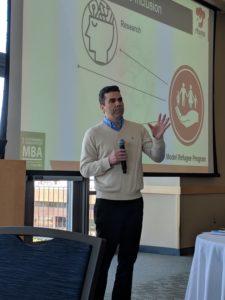
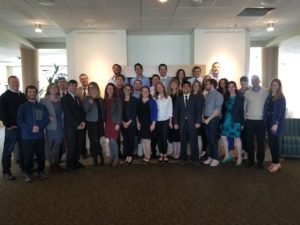 Students pitched scoping for projects at companies such as Keurig Green Mountain, Griffith Foods, Essilor, Seventh Generation, and Caterpillar.
Students pitched scoping for projects at companies such as Keurig Green Mountain, Griffith Foods, Essilor, Seventh Generation, and Caterpillar.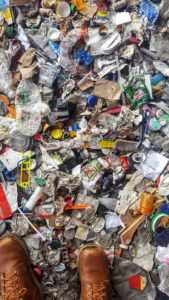 If you are like a lot of people you probably don’t, and you hope or wish that the items you put in the bin get recycled. But this “wishcycling” can actually do more harm than just throwing contaminated or non-recyclable items away. On a recent site visit to
If you are like a lot of people you probably don’t, and you hope or wish that the items you put in the bin get recycled. But this “wishcycling” can actually do more harm than just throwing contaminated or non-recyclable items away. On a recent site visit to 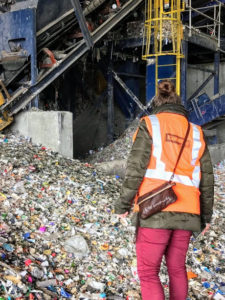 When non-recyclable items don’t make it through the system they are sent to the landfill or to an incinerator. This includes all of those small plastics, random pieces of metal, plastic bags, and more. This is why it is really important to check with your local recycler to see what products they take in the blue bin and which have special instructions.
When non-recyclable items don’t make it through the system they are sent to the landfill or to an incinerator. This includes all of those small plastics, random pieces of metal, plastic bags, and more. This is why it is really important to check with your local recycler to see what products they take in the blue bin and which have special instructions.